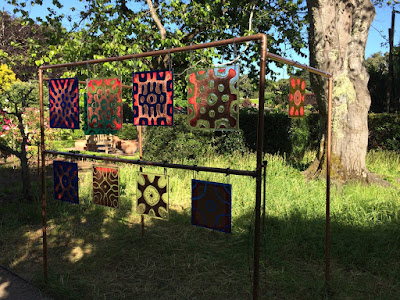In this post I describe my approach to creating a musical instrument made with fused glass. I had long ago noticed that a hanging panel of fused glass could make a pleasing sound when tapped (or hummed to). During the DoonArt Open Studios Tour in July 2017, I demonstrated and discussed this with Martin Gaskell, an astrophysicist who is also keenly interested in all things musical. We talked about the possibility of making fused art glass panels that would be in tune, musically speaking. We made some sound recordings and later in the summer, Martin taught me how to use free software called Audacity to analyze the frequency spectra produced by my art glass panels. This allowed me to begin testing, first with plate glass (cheaper), and next with fused art glass, to determine empirically if the laws of physics that govern acoustics function predictably in my art glass world (they do). Specifically, I was interested in finding the relationship between the size of a square piece of glass and the resonant frequencies (musical notes) it produces.
As I learned while auditing Martin's class on Physics and Psychophysics of Music at UCSC during Winter quarter 2018, for a square plate, frequency is inversely proportional to the area of the square. Frequency is also proportional to the thickness of the plate. Thus a tiny change in thickness will have a greater effect on the pitch than the same tiny change in the length of the side of a square. A simple way to put this is as follows, where f = frequency, L = length of a side of the square and b = thickness.
This means that for bell plates of the same thickness and material, a larger plate will have a lower frequency (lower value of Hz) than a smaller plate. And, for plates of the same L, a thinner plate will have lower Hz than a thicker plate. The latter makes sense if you understand that stiffness is a factor in sound generation; a thicker plate has less flexibility and therefore, higher pitch.
Back to practicalities: it is easier to cut glass in squares of different sizes (L) than to grind identical squares to very slightly differing thicknesses (b). I prepared some test panels and graphed the inverse square root of the frequency (1/√f) vs. length (L) of my test panels in Excel. I used the slope of the resulting line to calculate the L needed to obtain a desired frequency. This would be very predictive if the glass was all the same thickness, as with plate glass.
Unfortunately, I discovered that the art glass I am using varies considerably in thickness, not only from sheet to sheet, but also within one sheet! Thus I had to settle for cutting the glass close to the correct size and using a diamond coated lapping wheel to grind the edges of the fused panels until they were in tune, as shown below.
This works fine if the pitch is a bit flat, so I erred on the side of too large rather than too small - it's not possible to add a tiny bit of glass if the pitch is sharp! Due to the variation in thickness mentioned above, some panels ended up as much as 13 Hz below the desired pitch. This can take hours to correct by grinding, since I needed to stop and check the pitch frequently so as not to remove too much glass. Sometimes I was lucky, and the actual pitch was very close or identical to the pitch predicted by my graph.
Here's a short video of the square plate glass test series:
And a short video of my fused art glass test series:












